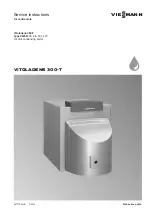
13
A
B
Fig. 6
Note
Traces of condensate indicate a leak.
1.
Remove thermal insulation strip
A
and pull ther-
mal insulation mat
B
out a little.
2.
Check the heat exchanger fixings for firm seating.
3.
Check the connector on the heat exchanger for
leaks.
Checking the connections on the heating water and DHW sides for leaks
Checking the safety valve function
Checking the diaphragm expansion vessel and system pressure
Fig. 7
Note
Observe the information provided by the manufacturer
of the diaphragm expansion vessel.
Carry out this test on a cold system.
1.
Drain the system until the pressure gauge indi-
cates "0" or close the cap valve on the diaphragm
expansion vessel and reduce the pressure in this
vessel.
2.
If the pre-charge pressure of the diaphragm expan-
sion vessel is lower than the static system pres-
sure, top up with nitrogen until the pre-charge pres-
sure is 0.1 to 0.2 bar (10 to 20 kPa) higher.
3.
Top up with water until the charge pressure of the
cooled system is 0.1 to 0.2 bar (10 to 20 kPa)
higher than the pre-charge pressure of the dia-
phragm expansion vessel.
Permiss. operating pressure: 3 bar (0.3 MPa)
Checking the thermal insulation for firm seating
Commissioning, inspection, maintenance
Checking the connections on the flue gas side for tightness
5671704






































